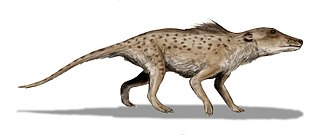
Pakicetidae is an extinct family of Archaeoceti that lived during the Early Eocene in Pakistan.
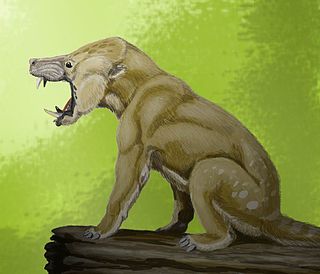
Condylarthra is an informal group – previously considered an order – of extinct placental mammals, known primarily from the Paleocene and Eocene epochs. They are considered early, primitive ungulates. It is now largely considered to be a wastebasket taxon, having served as a dumping ground for classifying ungulates which had not been clearly established as part of either Perissodactyla or Artiodactyla, being composed thus of several unrelated lineages.

Phenacodus is an extinct genus of mammals from the late Paleocene through middle Eocene, about 55 million years ago. It is one of the earliest and most primitive of the ungulates, typifying the family Phenacodontidae and the order Perissodactyla.
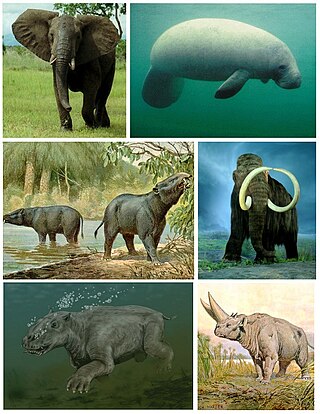
Tethytheria is a clade of mammals that includes the sirenians and proboscideans, as well as the extinct order Embrithopoda.

Panperissodactyla is a clade of ungulates containing living order Perissodactyla and all extinct ungulates more closely related to Perissodactyla than to Artiodactyla.
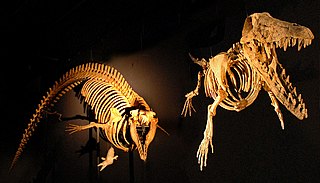
Archaeoceti, or Zeuglodontes in older literature, is a paraphyletic group of primitive cetaceans that lived from the Early Eocene to the late Oligocene. Representing the earliest cetacean radiation, they include the initial amphibious stages in cetacean evolution, thus are the ancestors of both modern cetacean suborders, Mysticeti and Odontoceti. This initial diversification occurred in the shallow waters that separated India and Asia 53 to 45 mya, resulting in some 30 species adapted to a fully oceanic life. Echolocation and filter-feeding evolved during a second radiation 36 to 35 mya.

Anthracobunidae is an extinct family of stem perissodactyls that lived in the early to middle Eocene period. They were originally considered to be a paraphyletic family of primitive proboscideans possibly ancestral to the Moeritheriidae and the desmostylians. The family has also thought to be ancestral to the Sirenia.

Anthracobune is an extinct genus of stem perissodactyl from the middle Eocene of the Upper Kuldana Formation of Kohat, Punjab, Pakistan.
Ishatherium is an extinct genus of ungulate from the early Eocene of the Subathu formation in northwestern India.
Lammidhania is an extinct genus of anthracobunids, which lived from the early to middle Eocene period. Its fossil remains were discovered in 1940 in the Chorlakki locality of the Punjab province of Pakistan.
Nakusia is an extinct genus of ungulate from the early Eocene epoch, described in 1999 in the Ghazij formation of Baluchistan, Pakistan. It was classified as an anthracobunid in 1999 but was suggested in a 2014 cladistic analysis to be more likely to belong to Quettacyonidae or Cambaytheriidae.
Hsanotherium is an extinct genus of early ungulate from the middle Eocene, described in 2000 in the Pondaung Formation, Myanmar.
Gandakasia is an extinct genus of ambulocetid from Pakistan, that lived in the Eocene epoch. It probably caught its prey near rivers or streams.

Ichthyolestes is an extinct genus of archaic cetacean that was endemic to Indo-Pakistan during the Lutetian stage. To date, this monotypic genus is only represented by Ichthyolestes pinfoldi.
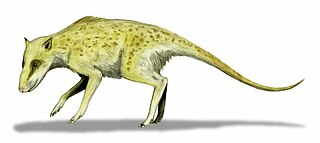
The Raoellidae, previously grouped within Helohyidae, are an extinct family of semiaquatic digitigrade artiodactyls in the clade Whippomorpha. Fossils of raoellids are found in Eocene strata of South and Southeast Asia.

Tillodontia is an extinct suborder of eutherian mammals known from the Early Paleocene to Late Eocene of China, the Late Paleocene to Middle Eocene of North America where they display their maximum species diversity, the Middle Eocene of Pakistan, and the Early Eocene of Europe. Leaving no descendants, they are most closely related to the pantodonts, another extinct group. The tillodonts were medium- to large-sized animals that probably feed on roots and tubers in temperate to subtropical habitats.
Indobune is an extinct genus of ungulate endemic to Asia during the Eocene from 55.8—48.6 Ma, living for approximately 7.2 million years.

Phenacodontidae is an extinct family of large herbivorous mammals traditionally placed in the “wastebasket taxon” Condylarthra, which may instead represent early-stage perissodactyls. They lived in the Paleocene and Eocene epochs and their fossil remains have been found in North America and Europe.
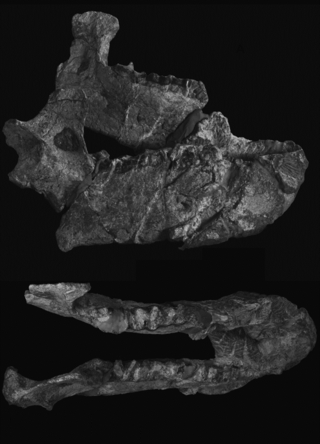
Obergfellia is an extinct genus of stem perissodactyl from the middle Eocene, discovered in 1980. Its known range includes northern India and Pakistan.
Cambaytherium is an extinct genus of placental mammals in the family Cambaytheriidae whose fossils were found in an open pit coal mine located in Gujarat, India. The mine was a treasure trove full of teeth and bones, over 200 of which were identified as belonging to Cambaytherium thewissi. The fossils were dated to the Early Eocene, 54.5 million years ago, making them slightly younger than the oldest known fossils belonging to the order Perissodactyla.












